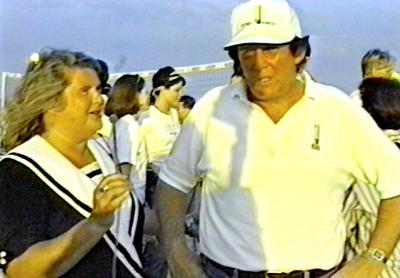Courting Disaster, by Richard Rosenthal
Courting Disaster, by Richard Rosenthal
If I were a local business owner summoned to court for violating our state or local disabilities laws, I might simply ask the judge, “Why should I comply when your court doesn’t?”
Since its completion in 2010 in the back of our history-themed town government complex, the $4 million East Hampton Justice Court has been defying New York State and town disabilities laws designed to guarantee access to people with disabilities and which the court is charged with enforcing. It also violates the Americans With Disabilities Act, which the federal government enforces.
Some of the court building’s extreme violations have been cleared up over the years, notably a heavy entrance door that frequently and unexpectedly slammed shut. This was particularly perilous to use during periods of congested pedestrian traffic entering or exiting the building. The path of travel through the street to the entrance from the handicapped reserved parking area bulged with an array of bubble-shaped lumps that was especially difficult for disabled people to use and suggested a geyser beneath that was about to blow.
It took more than a year to fix the dangerous door and uneven pavement. Major violations persist in the court’s handicapped-parking arrangement, which is tucked away in a notch around a 90-degree turn past the entrance door. The parking area itself is too tight to provide safe backing out and turning, and has no identified unloading-access aisle and only one marked parking space. Two spaces are required, as was noted in plans the developer filed with the Building Department in 2004.
Most important, the path of travel from the designated parking notch to the court building provides no curb cut or ramp for disabled court users or employees to ascend to the sidewalk and safely proceed off the street to the court’s entrance. The curb throughout the handicapped area is at least seven inches high — impossible to access if you use a wheelchair, treacherous if you use a cane or walker. The Americans With Disabilities Act requires that grab bars be situated on any curb that is higher than six inches. There are none.
As a result, a disabled person must traverse the street, potentially in the face of vehicles driving toward and around the right-angle curve to park there. This is a disaster waiting to happen.
An apparent quick fix exists. Readily reachable parking spaces with ample visibility and a level building entrance that easily can be made wheelchair-accessible are in place at the south side of the structure. Why not designate three of these for disabled people — two for parking plus a wheelchair-unloading aisle between them? If necessary, eight more spaces for the general public could easily be added to this location.
Use of this area looks obvious. I urged the Wilkinson board to check it out at a town board meeting in 2011. But neither this nor any other serious proposal to produce a solution has been undertaken by any town board or by the disabilities advisory board, which I also informed of the dangers and violations five years ago. I reported these issues to the Ordinance Enforcement Department in 2012. I was promised a response within a week, but have not heard back.
How did it all come to this — a new justice court’s disregard for the law and the various town boards’ indulgence of it now for so long? A.D.A. compliance in the old Town Hall-court building was excellent, having been seen to by the Bullock administration circa 1993. Why was such attentiveness to the law and the needs of so many East Hampton residents set aside in the construction of our new court? Why has it been left that way by three town administrations that respond to questions and suggestions about it with what amounts to one long Gallic shrug?
An explanation is that the new justice court was built backward. Really. I don’t have the comic genius to make this up. It’s Laurel and Hardy stuff. It’s become a regular joke around town offices that “Ho-ho-ho, they put it in backwards,” which could logically explain how the back became the entrance, requiring contortions to provide handicapped access space near it. But that cannot justify the town’s apathy in dealing with this situation.
We advocates have passively consented to this neglect for years now, regardless of the Gandhi and Martin Luther King quotes we keep pinned on walls over our desks.
Both the A.D.A. in 1991 and our local law in 2003 were enacted with overwhelming bipartisan support. In fact, two Republicans led the effort: President George H.W. Bush at the national level and Supervisor Jay Schneiderman, then a Republican, in East Hampton.
These were good days for the town, the culmination of a respectful, firm activism that promised to bring our 1,000-plus disabled year-round residents out of isolation into the participatory mainstream of the town’s social, political, and commercial life. But for the past 10 years or so, it’s the complacency that has been bipartisan.
A very effective leader during our early endeavors was the East Hampton Village clerk, Larry Cantwell, who negotiated such important settlements as the access compliance of East Hampton’s U.A. Cinema. Other U.A. cinemas in Southampton, Hampton Bays, and elsewhere on Long Island quickly followed suit, installing wheelchair spaces, accessible bathroom facilities, and FM assistive-listening systems. I believe that now, as town supervisor, he would enjoy making things right again.
Which brings to mind a story, perhaps apocryphal, about President Franklin Roosevelt. Early in his first term, a group of labor leaders visited him and urged his support for legislation they favored. F.D.R. listened silently as they passionately presented their case. When they finished, he leaned forward in his wheelchair and said, “All right, gentlemen, you have convinced me. I am in favor of your proposal. Now go out and make me do it.”
Richard Rosenthal was disabilities advocate for East Hampton Town from 1993 to 2002.


